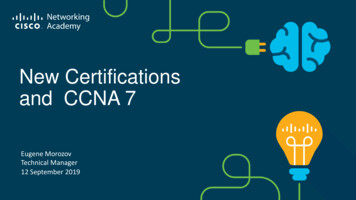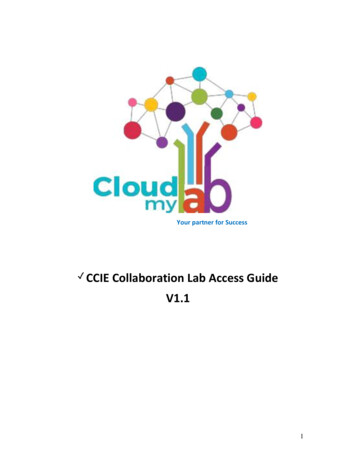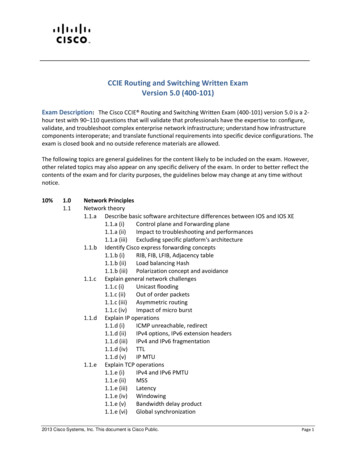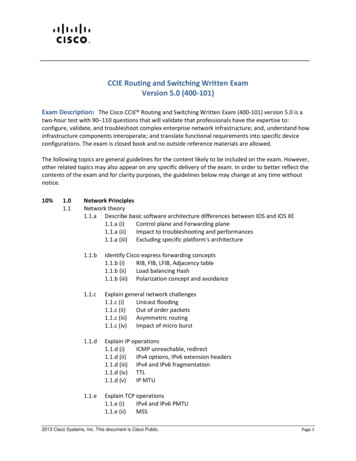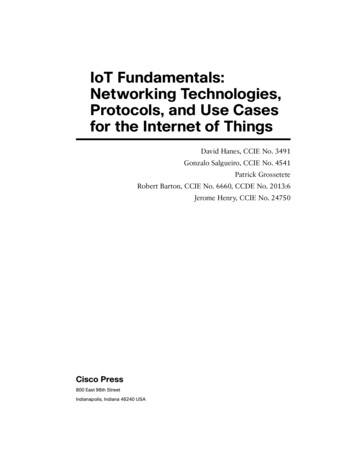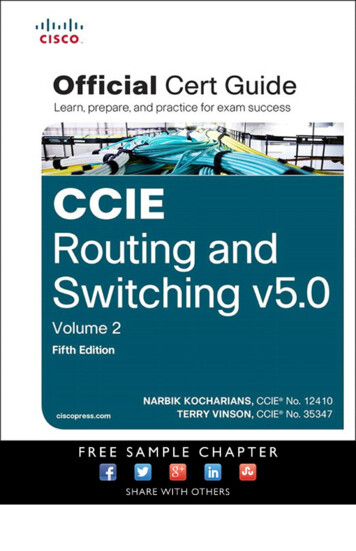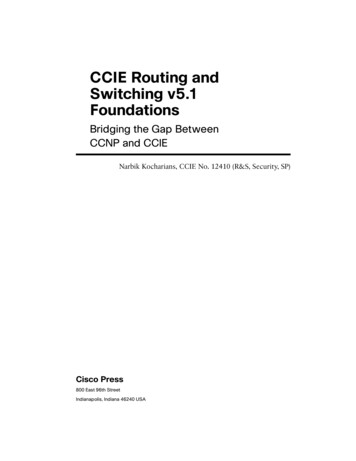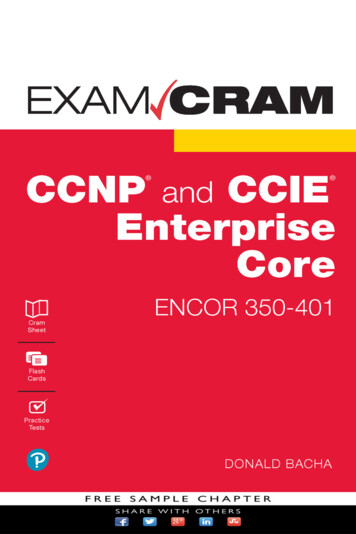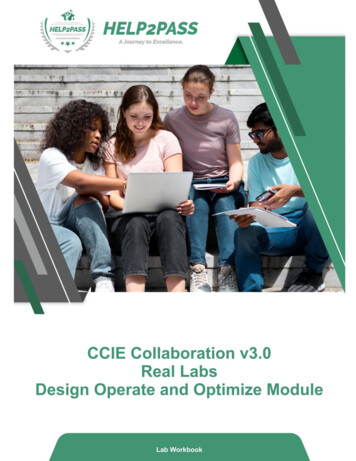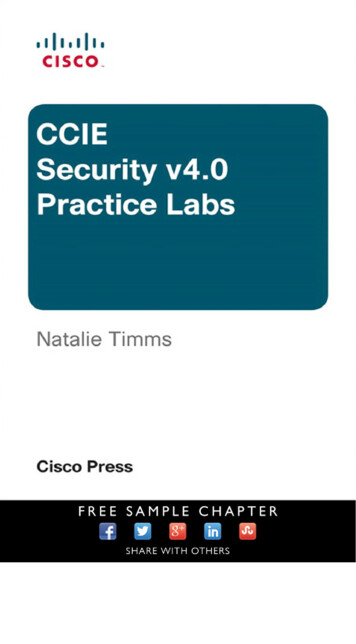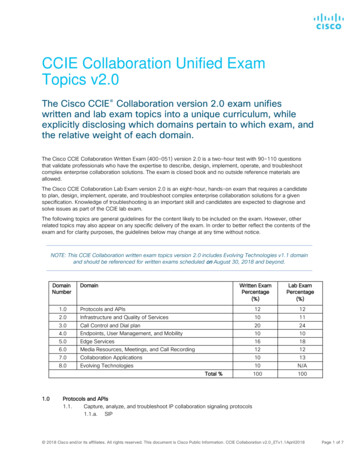
Transcription
CCIE Collaboration Unified ExamTopics v2.0The Cisco CCIE Collaboration version 2.0 exam unifieswritten and lab exam topics into a unique curriculum, whileexplicitly disclosing which domains pertain to which exam, andthe relative weight of each domain.PPThe Cisco CCIE Collaboration Written Exam (400-051) version 2.0 is a two-hour test with 90–110 questionsthat validate professionals who have the expertise to describe, design, implement, operate, and troubleshootcomplex enterprise collaboration solutions. The exam is closed book and no outside reference materials areallowed.The Cisco CCIE Collaboration Lab Exam version 2.0 is an eight-hour, hands-on exam that requires a candidateto plan, design, implement, operate, and troubleshoot complex enterprise collaboration solutions for a givenspecification. Knowledge of troubleshooting is an important skill and candidates are expected to diagnose andsolve issues as part of the CCIE lab exam.The following topics are general guidelines for the content likely to be included on the exam. However, otherrelated topics may also appear on any specific delivery of the exam. In order to better reflect the contents of theexam and for clarity purposes, the guidelines below may change at any time without notice.NOTE: This CCIE Collaboration written exam topics version 2.0 includes Evolving Technologies v1.1 domainand should be referenced for written exams scheduled on August 30, 2018 and beyond.DomainNumberDomainWritten ExamPercentage(%)1.0Protocols and APIs12122.0Infrastructure and Quality of Services10113.0Call Control and Dial plan20244.0Endpoints, User Management, and Mobility10105.0Edge Services16186.0Media Resources, Meetings, and Call Recording12127.0Collaboration Applications10138.0Evolving Technologies10N/A100100Total %1.0Lab ExamPercentage(%)Protocols and APIs1.1.Capture, analyze, and troubleshoot IP collaboration signaling protocols1.1.a. SIP 2018 Cisco and/or its affiliates. All rights reserved. This document is Cisco Public Information. CCIE Collaboration v2.0 ETv1.1April2018Page 1 of 7
CCIE Collaboration Unified Exam Topics v2.01.2.1.3.1.4.1.5.1.6.1.7.1.8.1.9.2.01.1.b. H.3231.1.c. MGCP1.1.d. SCCPImplement and troubleshoot SDP and media negotiation1.2.a. Offer/Answer model1.2.b. Early offer, delayed offer, early media1.2.c. Payload type interworkingAnalyze and troubleshoot SIP identity headers1.3.a. Name1.3.b. Number1.3.c. URI1.3.d. PrivacyCapture, analyze, and troubleshoot media protocols1.4.a. RTP/RTCP, sRTP/sRTCP1.4.b. Binary Floor Control Protocol (BFCP)1.4.c. ActiveControl (iX)1.4.d. T.38Design, implement, and troubleshoot DTMF relay1.5.a. In-band vs out-of-band1.5.b. RFC 28331.5.c. Key Pad Markup Language (KPML)1.5.d. Unsolicited NOTIFY1.5.e. InterworkingCapture, analyze, and troubleshoot messaging protocols1.6.a. XMPP1.6.b. SIP/SIMPLECapture, analyze, and troubleshoot legacy telephony protocols1.7.a. Analog (FXS, FXO, loop-start, ground-start)1.7.b. Q.931Utilize and troubleshoot the following APIs1.8.a. Cisco Meeting Server API1.8.b. Unified CM Administrative XML (AXL) API1.8.c. Spark API1.8.d. Tropo APIDescribe the functionality of the following APIs1.9.a. Cisco Unity Connection Provisioning Interface (CUPI)1.9.b. Java Telephony Application Programming Interface (JTAPI)1.9.c. Extension Mobility API (EMAPI)1.9.d. UC Gateway Services API (GSAPI)1.9.e. Unified Routing Rules XML Interface (CURRI)Infrastructure and Quality of Services2.1.Implement and troubleshoot network services2.1.a. DHCP2.1.b. NTP2.1.c. DNS2.1.d. CDP/LLDP2.2.Troubleshoot layer 2 and layer 3 network connectivity issues 2018 Cisco and/or its affiliates. All rights reserved. This document is Cisco Public Information. CCIE Collaboration v2.0 ETv1.1April2018Page 2 of 7
CCIE Collaboration Unified Exam Topics v2.02.3.2.4.2.5.2.6.2.7.2.8.2.9.2.10.3.0Identify key implications of running collaboration in a wireless environment2.3.a. 802.11k, 802.11v, 802.11r2.3.b. QoSDesign, implement, and troubleshoot Quality of Service for Collaboration applications andendpoints on LAN/WAN/WLAN (Cisco IOS-XE and AireOS)2.4.a. Identification2.4.b. Classification and marking2.4.c. Queuing and scheduling2.4.d. Congestion managementTroubleshoot voice and video quality issues2.5.a. Packet loss, jitter, and latency2.5.b. Endpoint call quality metrics2.5.c. One-way or no-way mediaCollect and analyze packet captures on Cisco Collaboration platformsDesign, implement, and troubleshoot Enhanced Locations Call Admission Control (ELCAC)Design, implement, and troubleshoot Call Admission Control on CUBEDescribe APIC-EM integration with Cisco Collaboration solutionsDesign, implement, and troubleshoot Collaboration applications in a virtualized environment2.10.a. Virtual machine templates2.10.b. Hypervisors2.10.c. Resource utilization (CPU, memory, storage, network)Call Control and Dial plan3.1.Design and analyze global dial plans3.1.a. Localization and globalization3.1.b. Numbering schemes3.1.c. Dialing habits3.1.d. Interdigit timeouts3.1.e. Calling privileges3.1.f.Number presentation3.2.Design, implement, and troubleshoot fundamental dial plan features on Unified CM3.2.a. Partitions and calling search spaces3.2.b. Translation and transformation patterns3.2.c. Urgent priority3.2.d. Path selection3.2.e. AAR3.3.Design, implement, and troubleshoot advanced dial plan features on Unified CM3.3.a. Global dial plan replication3.3.b. Local route groups3.4.Design, implement, and troubleshoot URI and domain-based routing3.5.Implement and troubleshoot Unified CM telephony features3.5.a. Call Pickup3.5.b. Barge/privacy3.5.c. Native call queuing3.5.d. Intercom3.5.e. Music on hold (unicast and multicast)3.6.Design, implement, and troubleshoot audio and video codec selection3.7.Implement and troubleshoot SIP trunking 2018 Cisco and/or its affiliates. All rights reserved. This document is Cisco Public Information. CCIE Collaboration v2.0 ETv1.1April2018Page 3 of 7
CCIE Collaboration Unified Exam Topics v2.03.8.3.9.3.10.3.11.3.12.3.13.3.14.4.03.7.a. SIP profiles3.7.b. SIP trunk security profiles3.7.c. Resiliency3.7.d. Mid-call signalingImplement and troubleshoot UDS in a multi-cluster environment3.8.a. Service discovery3.8.b. User search3.8.c. LDAP proxyVerify and troubleshoot Unified CM database replicationDesign, implement, and troubleshoot dial plans on Cisco IOS-XE3.10.a. Inbound and outbound dial-peers3.10.b. Voice translation rules and profiles3.10.c. Dial-peer provisioning policy3.10.d. Destination server groups3.10.e. Destination dial-peer groups3.10.f. E.164 pattern maps3.10.g. URI-based dialing3.10.h. VRF-aware call routingImplement and troubleshoot SIP call control for Unified CME3.11.a. Extension Assigner3.11.b. Secondary CME support3.11.c. Video support3.11.d. Telephony featuresImplement and troubleshoot SIP-SRST and E-SRSTDesign, implement, and troubleshoot dial plans on Expressway Series3.13.a. Transforms3.13.b. Search rules3.13.c. Zones3.13.d. SubzonesImplement and troubleshoot Cisco Spark Services3.14.a. Extending cloud services using on premise resources3.14.b. Cloud service managementEndpoints, User Management, and Mobility4.1.Implement and troubleshoot hardware and software endpoint registration in a multi-clusterenvironment4.1.a. On-premise (local or proxy TFTP)4.1.b. Mobile and Remote Access (Service Discovery)4.1.c. Cloud4.2.Implement and troubleshoot mixed mode and Security By Default (SBD) on Unified CM4.2.a. Certificate Trust List (CTL) and Identity Trust List (ITL)4.2.b. Token and token-less4.2.c. Trust Verification Service (TVS)4.3.Implement collaboration endpoints and infrastructure using IPv64.4.Implement and troubleshoot endpoint features4.4.a. Proximity4.4.b. Directory integration and search4.4.c. Product specific configurations 2018 Cisco and/or its affiliates. All rights reserved. This document is Cisco Public Information. CCIE Collaboration v2.0 ETv1.1April2018Page 4 of 7
CCIE Collaboration Unified Exam Topics v2.04.5.4.6.4.7.4.8.4.9.5.04.4.d. MultistreamIntegrate and troubleshoot LDAP synchronization and authentication4.5.a. On-premise4.5.b. CloudIntegrate and troubleshoot Single-Sign-On (SSO)Implement and troubleshoot self-provisioningImplement and troubleshoot mobility features4.8.a. Mobile Connect (Single Number Reach)4.8.b. Device Mobility4.8.c. Mobile Identity4.8.d. Extend and ConnectImplement and troubleshoot Extension Mobility Cross Cluster (EMCC)4.9.a. Emergency dialing considerations4.9.b. Certificate exchangeEdge Services5.1.Implement and troubleshoot ISDN PRI gateways5.2.Implement and troubleshoot SIP trunks in a multi-tenant environment5.2.a. Authentication5.2.b. Multi-VRF SIP trunks5.3.Implement and troubleshoot SIP normalization and SDP normalization5.3.a. Normalization and transparency scripts (Lua)5.3.b. Cisco IOS-XE SIP profiles5.4.Implement and troubleshoot encrypted signaling and media on trunks5.5.Implement and troubleshoot stateful box-to-box redundancy on CUBE (Cisco IOS-XE)5.6.Implement and troubleshoot network and application level security on Cisco IOS-XE5.6.a. IP Trust List5.6.b. Call spike protection5.6.c. Media policing5.6.d. Call thresholds5.6.e. RTP port ranges5.6.f.Telephony denial of service attacks5.7.Design, analyze, and troubleshoot firewall traversal in a Collaboration solution5.7.a. Port numbers and transport5.7.b. NAT5.7.c. Proxy servers5.7.d. Deep Packet Inspection considerations5.7.e. Trusted Relay Point5.7.f.Interactive Connectivity Establishment (ICE)5.8.Implement and troubleshoot Expressway Series traversal communications5.8.a. Traversal zone5.8.b. SSH tunnels5.9.Implement and troubleshoot Mobile and Remote Access (MRA)5.10.Implement and troubleshoot network and application level security on Expressway Series5.10.a. Toll fraud prevention (CPL)5.10.b. Zone and subzone authentication5.10.c. Automated intrusion protection5.10.d. Mutual TLS 2018 Cisco and/or its affiliates. All rights reserved. This document is Cisco Public Information. CCIE Collaboration v2.0 ETv1.1April2018Page 5 of 7
CCIE Collaboration Unified Exam Topics v2.05.11.5.12.5.13.Implement and troubleshoot call routing for Spark hybrid services and Business-to-Business(B2B) callingImplement and troubleshoot Spark hybrid service connectors and containersImplement and troubleshoot third-party interoperability and federation5.13.a. Voice and video calling5.13.b. IM&P6.0Media Resources, Meetings, and Call Recording6.1.Design, implement, and troubleshoot media resources6.1.a. Transcoding and transrating6.1.b. MTP6.2.Implement and troubleshoot rendezvous conferencing6.2.a. Unified CM Conference Now6.2.b. Cisco Meeting Server Spaces6.3.Implement and troubleshoot ad-hoc conferencing6.3.a. Cisco IOS-XE conferencing6.3.b. Cisco Meeting Server6.3.c. Cloud6.4.Implement and troubleshoot scheduled meetings6.4.a. On-premise6.4.b. Hybrid6.4.c. Cloud6.5.Implement and troubleshoot CallBridge and WebBridge on Cisco Meeting Server6.5.a. Internal user access6.5.b. External user access6.6.Implement and troubleshoot high availability on Cisco Meeting Server6.7.Design, implement, and troubleshoot audio and video call recording architectures6.7.a. Open Recording Architecture (ORA)6.7.b. SIP-based Media Recording (SIPREC)6.7.c. Network-Based Recording (gateway preferred)6.7.d. Built-in bridge6.7.e. Cisco Meeting Server7.0Collaboration Applications7.1.Implement and troubleshoot on premise IM&P servers and clients7.2.Implement and troubleshoot presence7.2.a. Busy Lamp Field (BLF)7.2.b. Soft client7.2.c. Cloud7.3.Integrate IM&P server with external database to enable Persistent Chat and Group Chat7.4.Implement and troubleshoot voicemail integration7.4.a. Cisco Unity Connection7.4.b. Virtual Cisco Unity Express (vCUE)7.5.Implement and troubleshoot voicemail features7.5.a. Call and directory handlers7.5.b. Voicemail access from soft clients7.5.c. Video greetings and messaging7.6.Implement and troubleshoot voicemail dial plan7.6.a. Partitions and search spaces 2018 Cisco and/or its affiliates. All rights reserved. This document is Cisco Public Information. CCIE Collaboration v2.0 ETv1.1April2018Page 6 of 7
CCIE Collaboration Unified Exam Topics v2.07.7.7.8.7.9.8.07.6.b. Routing rulesImplement and troubleshoot voicemail digital networkingDesign, implement, and troubleshoot Cisco Unified Contact Center Express (UCCX)7.8.a. Integration7.8.b. ScriptingImplement and troubleshoot Contact Center agent desktop (Finesse)Evolving Technologies v1.18.1Cloud8.1.aCompare and contrast public, private, hybrid, and multicloud design considerations8.1.a (i)Infrastructure, platform, and software as a service (XaaS)8.1.a (ii)Performance, scalability, and high availability8.1.a (iii)Security implications, compliance, and policy8.1.a (iv)Workload migration8.1.bDescribe cloud infrastructure and operations8.1.b (i)Compute virtualization (containers and virtual machines)8.1.b (ii)Connectivity (virtual switches, SD-WAN and SD-Access)8.1.b (iii)Virtualization functions (NFVi, VNF, and L4/L8)8.1.b (iv)Automation and orchestration tools (CloudCenter, DNA-center, andKubernetes)8.2Network programmability (SDN)8.2.aDescribe architectural and operational considerations for a programmable network8.2.a (i)Data models and structures (YANG, JSON and XML)8.2.a (ii)Device programmability (gRPC, NETCONF and RESTCONF)8.2.a (iii)Controller based network design (policy driven configuration andnorthbound/ southbound APIs)8.2.a (iv)Configuration management tools (agent and agentless) and versioncontrol systems (Git and SVN)8.3Internet of things (IoT)8.3.aDescribe architectural framework and deployment considerations for IoT8.3.a (i)IoT technology stack (IoT Network Hierarchy, data acquisition and flow)8.3.a (ii)IoT standards and protocols (characteristics within IT and OTenvironment)8.3.a (iii)IoT security (network segmentation, device profiling, and secure remoteaccess)8.3.a (iv)IoT edge and fog computing (data aggregation and edge intelligence)Printed in USA 2018 Cisco and/or its affiliates. All rights reserved. This document is Cisco Public Information. CCIE Collaboration v2.0 ETv1.1April2018Page 7 of 7
The Cisco CCIE Collaboration Lab Exam version 2.0 is an eight -hour, hands-on exam that requires a candidate to plan, design, implement, operate, and troubleshoot complex enterprise collaboration solutions for a given specification. Knowledge of troubl eshooting is an important skill and candidates are expected to diagnose and
